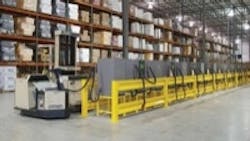It's lunchtime at International Paper's redistribution center. Order pickers and reach trucks pull up one by one outside the break room. The operators dismount, connect their trucks to fast chargers and walk away without touching a button. The chargers sense the connection, read the batteries and deliver precisely tailored charges. Thirty minutes later the trucks are on the move again, with plenty of power to last until the next break.
When International Paper (www.internationalpaper.com) decided to break ground on one of its largest distribution facilities (460,000 sq. ft.) in Cincinnati, they were looking for ideas to increase productivity and safety. OKI Systems (www.okisys.com), the local Crown dealer in Cincinnati, suggested fast charging as a way to operate with only one battery per vehicle and do away with battery changes. They recommended the Express fast charging system due to a successful track record of the single source battery and charger solution. The Express system is the result of a partnership between battery experts from EnerSys (Reading, Pa., www.enersysinc.com) and power electronics specialists from Aker Wade Power Technologies (Charlottesville, Va., www.akerwade.com).
Len Schroer, operations manager at International Paper's Cincinnati redistribution center was interested. He had a history of making smart technology investments that have paid off. In 1985 he implemented computerized routing and moved to on-board computers in 1989. By 1990 he was using PC-based RF management for his whole fleet.
When he studied the Express fast charging system in 2004 he thought it was an idea whose "time had come." It made too much sense to keep the battery in the vehicle and let the operators "fill up" during their breaks and between shifts. And, in Schroer's mind, it made no sense to dedicate three times as much space for a battery room and fill it with maintenance intensive changing equipment. So he decided to present the idea to corporate management.
International Paper executives were very interested, but the concept first had to pass their financial hurdles for new technology investments. In the analysis the additional investment in fast chargers and electrical infrastructure was completely offset by the reduction in batteries and the elimination of the battery room.
"Basically it was a wash," says Schroer. But where they saved big was in productivity. By eliminating battery changes they were able to save 40,000 hours and reap an annual productivity benefit of $1 million. "We were saving money from day one by not losing time to changing batteries," he says.
Some managers who are considering fast charging are concerned about battery life. However, a decade of experience in the U.S. market has shown that opportunity fast charging has a positive impact on battery performance, according to Bret Aker, CEO of Aker Wade. Companies that have undergone enterprise-wide conversions such as General Motors are seeing battery lifetimes in excessof the manufacturer warranties at two- and three-shift facilities,he reports. Why? Batteries sulfate less when kept at a higher average state of charge.
Backing up Aker's claims is David Boden, Ph.D. electrochemist, lead acid battery specialist and independent consultant based in Charlottesville, Va. "I have personally performed battery teardown analyses on batteries charged by the Express fast chargers. They were all in good condition after 3 years of service with no sulfation and were capable of much longer service," says Boden.
Today, International Paper is running 85 trucks 24 hours per day, five to six days per week. There have been no battery changes for two years. And Schroer expects the batteries to last at least another two years, up to their full four-year warranty.
What about safety? As Schroer describes, "Every operations manager who has been in the business long enough has seen at least a near-miss incident involving batteries." With fast charging, battery-changing accidents are a thing of the past. As a result, worker's compensation allocations at International Paper have gone "way down," he reports.
| Fast Charging Productivity Savings @ International Paper |
Row of fast charging stations at International Paper DC in Cincinnati.
